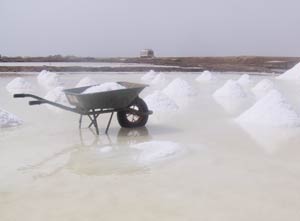Why do few people separate fresh water from sea water?
When cities sink because of fresh water, the obvious solution will be seawater separation. But in fact, this technology has been very slow for thousands of years. Although it is easy to desalinate from water, the energy required for this is still difficult to accept.
"Until recently, desalination from seawater was still an extremely expensive solution , " said Gary Crisp, an engineer at Western Australia Water Corporation.
Direct drinking of seawater is a bad idea because your body must use a larger amount of water to excrete salt through the urinary tract. Seawater contains about 130 g of salt per gallon (about 4.5 liters). Desalination can reduce salt to less than 2 grams per gallon, which is a safe limit for people to drink.
Currently, there are about 10 to 13 billion gallons of desalinated seawater worldwide every day. They only account for 0.2% of total consumption globally. This number is increasing.
Aristotle's efforts
 (Artwork: ag.arizona.edu) Back in the 4th century BC, Aristotle envisioned the use of filters to remove salt from seawater. But the first practical activity uses the distillation method, which is to boil sea water to collect steam. Around 200 AD, sailors began separating seawater with simple boilers on board.
(Artwork: ag.arizona.edu) Back in the 4th century BC, Aristotle envisioned the use of filters to remove salt from seawater. But the first practical activity uses the distillation method, which is to boil sea water to collect steam. Around 200 AD, sailors began separating seawater with simple boilers on board.
The energy needed for this technology makes it too expensive on a large scale. Therefore, the main market for this " thermal desalination " technology is in the oil-rich countries of the Middle East, where water is extremely scarce.
Since the 1950s, researchers have developed membranes that can filter salt, similar to Aristotle's visualization. Currently, this membrane technology requires up to a quarter of the energy and half the cost of the distillation method.
"In the last 10 years, membrane technology has been improved to replace the distillation technique , " Crisp said.
Energy is the key
But even with filters, people still have to use a lot of energy to generate high pressure, enough to force water to flow through the filters. Current methods require 14 kWh of electricity to desalinate 1,000 gallons of seawater.
An average American currently consumes 80 to 100 gallons of water per day. The entire country uses about 323 billion gallons of surface water and 84.5 billion gallons of groundwater per day and night. If half of them were born from seawater reduction techniques, the US would need another 100 power plants, and each plant would have a capacity of 1 gigawatt.
Currently, the rate of water use is twice as fast as the population growth rate, causing many communities to fall into water scarcity. That demand pushes water prices higher and higher, making desalination of seawater attractive.
T. An
- Create fresh water with solar energy
- 8th graders make devices that turn seawater into fresh water
- 50% of the world's population lacks fresh water by 2050
- Turning seawater into fresh water for Truong Sa soldiers
- Successfully tried the fresh water treatment system in Ly Son
- Do you know humans drinking dinosaur urine?
- The two boys turned seawater into fresh water thanks to the waves
- Salt water can generate 1,000 times more electricity than a solar battery
- Turn seawater into fresh water at a super cheap cost
- 'Digging mine' fresh water in the seabed
- New sources of fresh water from the sea?
- Lack of water, science race to filter seawater into fresh water
 'Fine laughs' - Scary and painful torture in ancient times
'Fine laughs' - Scary and painful torture in ancient times The sequence of numbers 142857 of the Egyptian pyramids is known as the strangest number in the world - Why?
The sequence of numbers 142857 of the Egyptian pyramids is known as the strangest number in the world - Why? History of the iron
History of the iron What is alum?
What is alum?